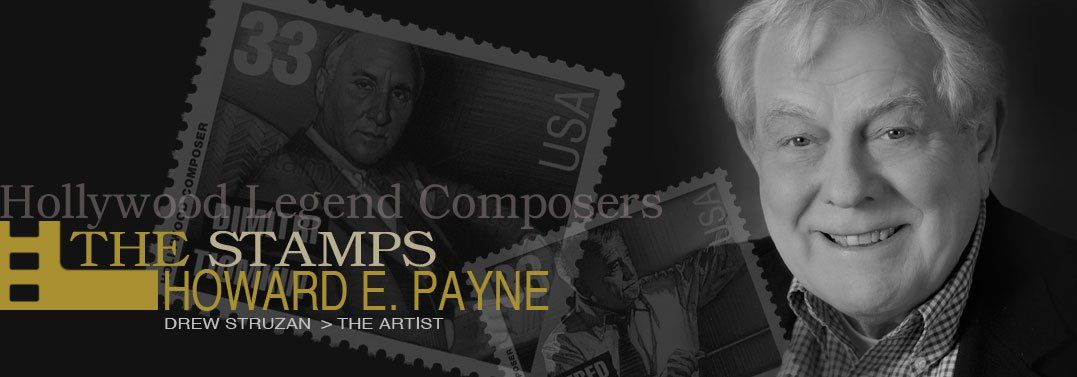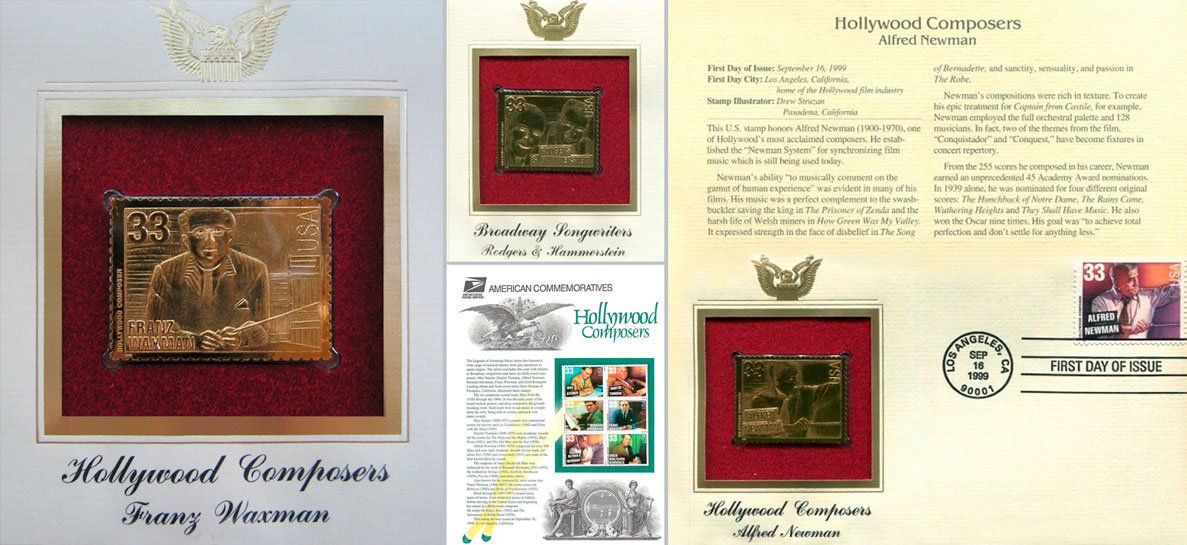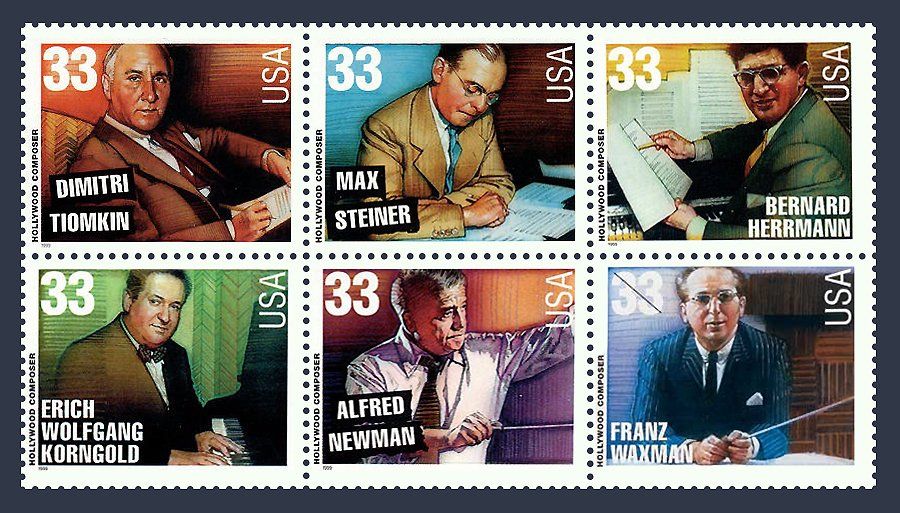Les timbres d'Hollywood

Hollywood Composers Stamp dévoilement Hollywood Bowl, 2301 N. Highland Ave. Oui, il serait difficile de ne pas reconnaître la patte artistique de Drew Struzan, illustrateur, portraitiste et affichiste renommé aux États Unis. C’est pour ce grand projet postal, de la pointe de ses crayons et de son aérographe que l’artiste immortalisa six des plus grands monstres de la musique de film américaine de l’époque du Golden Age. Ces six timbres remarquables furent commandés et produits par Howard Paine, qui travailla comme directeur artistique du magazine National Geographic pendant de nombreuses années et fut responsable de la création d’un grand nombre de timbres postaux américains. Ses expériences de carrière l'ont placé au centre de ce qu'il appella «l'affaire du collectionneur». Il fut également l'un des six directeurs artistiques de la United States Postal Service.
La collection de timbres fut lancés le 16 septembre 1999 à Los Angeles pour une valeur de 33 cents chacun. Avec son style vif, dynamique et coloré, Struzan capte avec grande précision les traits de chaque compositeur. Max Steiner, Dimitri Tiomkin, Alfred Newman, Bernard Herrmann, Franz Waxman et Erich Wolfgang Korngold. Tous des compositeurs primés de l'Académie Américaine qui ont écrit quelques-unes des plus mémorables musiques des films hollywoodiennes des années 1930 aux années 1960. Plus de 42,5 millions de timbres ont été imprimés par l’Imprimerie Sterling Sommer en offset. En plus de ces six timbres, une collection de 28 timbres d’autres grands créateurs Américains de musiques (paroliers, chanteurs…), furent présentés lors de la cérémonie d’inauguration qui eu lieu au Hollywood Bowl de Los Angeles. (voir illustration Broadway, Rodgers and Hammerstein).
C’est l'historien Leonard Maltin qui fut l'hôte de l'événement, il mit en vedette le directeur de l'
American Film Institute , Jean Picker Firstenberg et le chef d’orchestre John Mauceri, qui dirigea avec succès l'Hollywood Bowl Orchestra pour un mini concert hommage aux six compositeurs illustrés avec au programme des suites de GONE WITH THE WIND, THE ADVENTURES OF ROBIN HOOD et VERTIGO.
Azeezaly Jaffer, directeur exécutif des circuits de timbres pour le service postal des Etats-Unis annonça la diffusion des six timbres de Hollywood Composers ainsi que six timbres de Broadway à paraître. Il précisa que ce sont les derniers de la série Legends of American Music créée en 1993.
Jaffer déclara également que le processus de sélection et de conception remonte à 1991 avec les recommandations initiales du Citizens Stamp Advisory Committee, qui ont été examinées par des musicologues de la Smithsonian Institution et d'autres experts. «Après de nombreuses années de négligence, et parfois pire que la négligence, les compositeurs de la musique de film sont traités enfin comme des héros américains, avec des athlètes, des présidents et des personnalités politiques de toutes sortes», a t-il dit. «Nous voulions faire quelque chose qui allait raviver les moments de notre passé, susciter l'imagination et l'intérêt pour les leaders et les chefs d'orchestre de demain.»
En fait, quatre des six compositeurs illustrés étaient des émigrés européens. Steiner et Korngold étaient autrichiens, Waxman était allemand, Tiomkin un russe. Herrmann était un New-Yorkais et Newman est né à New Haven, Connecticut. Tous les six sont arrivés à Hollywood dans une période de 10 ans (1929-39) et, alors que trois d'entre eux ont également eu des carrières dans la musique de concert, tous ont dû leur renommée par le film. Steiner et Newman sont venus à Hollywood après un énorme succès en tant que chefs d’orchestre de Broadway dans les années 20.
Des Grands Maitres de la musique de film du «Golden Age» par la post
Max Steiner
(1888-1971) comptait plus de 300 musiques de films à son actif avec des partitions telles que KING KONG et GONE WITH THE WIND.
Alfred Newman
(1900-1970) fut le compositeur le plus honoré de l'histoire d'Hollywood, remportant neuf Oscars sur 45 nominations. Directeur musical de 20th Century Fox dans les années 40 et 50, il fut considéré comme le meilleur chef d'orchestre du cinéma et composa des partitions aussi mémorables que WUTHERING HEIGHTS, ALL ABOUT EVE et HOW THE WEST WAS WON. Il semblait particulièrement inspiré par des sujets religieux, notamment THE SONG OF BERNADETTE, THE ROBE et THE GREATEST STORY EVER TOLD. Newman était le patriarche d'une dynastie comportant, ses frères Lionel et Emil, ses fils David et Thomas, sa fille Maria et son neveu Randy.
David Newman, fils d'Alfred présent lors de l’inauguration déclara, «c’est toute l'industrie de la musique de film qui est honorée par cet événement».
Erich Wolfgang Korngold (1897-1957) était déjà un compositeur de renom dans sa Vienne natale avant de faire Hollywood sa maison dans la fin des années '30. Il considérait la musique de film comme un opéras sans chant et écrivait des partitions étonnamment romantiques pour Errol Flynn comme CAPTAIN BLOOD, THE ADVENTURES OF ROBIN HOOD, THE PRIVATE LIVES OF ELIZABETH AND ESSEX et THE SEA HAWK.
Franz Waxman (1906-1967) a travaillé dans l'industrie cinématographique allemande. Chassé de Berlin par les nazis en 1934, il se retrouve à Hollywood et se prend dans les toiles d’Alfred Hitchcock avec REBECCA et REAR WINDOW, puis SUNSET BOULEVARD de Billy Wilder, THE SPIRIT OF ST. LOUIS, A PLACE IN THE SUN et PEYTON PLACE. Il fonda ensuite le Los Angeles Music Festival en 1947 et fut son principal chef d'orchestre.
John Waxman, le fils de Franz Waxman, pense que son père aurait été vraiment ravi que son pays d'adoption l'ait honoré de cette façon. «Voici un homme venu d'un pays où les seules personnes illustrées sur des timbres sont des dictateurs ou des chiens.» John Waxman était particulièrement fier qu'une photographie qu'il ait prise de son père en 1960 ait été choisie comme base pour le timbre.
Bernard Herrmann
(1911-1975), considérée comme l’un des maitres absolus de la musique cinématographique américaine n’hésita pas à utiliser neuf harpes pour le score BENEATH THE 12-MILE REEF, deux theremins pour THE DAY THE EARTH STOOD STILL, ou le serpent pour JOURNEY TO THE CENTER OF THE EARTH. Sans oublié son long travail pour Hitchcock sur des films tels que PSYCHO, VERTIGO et NORTH BY NORTHWEST.
Dorothy Herrmann, la fille de Bernard Herrmann, déclara qu'elle pensait «que son père aurait été extrêmement heureux de cela. Pour toute sa vie, il voulait vraiment que les gens acceptent la musique de film comme un art important.»
Dimitri Tiomkin
(1894-1979) fut probablement le plus grand showman parmi les compositeurs hollywoodiens, souvent cité dans la presse et parmi les premiers à faire campagne pour les Oscars. Homme d'affaires perspicace, il a été parmi les premiers à chercher les droits d'édition de sa propre musique (un mouvement inhabituel, puisque les studios insistent pour être propriétaires de la musique dans leurs films). Pour Frank Capra, il a écrit LOST HORIZON, MR. SMITH GOES TO WASHINGTON et IT'S A WONDERFUL LIFE. Puis devint plus tard un spécialiste de l'Ouest sauvage avec des partitions comme HIGH NOON, DUEL IN THE SUN et THE ALAMO.
Olivia Tiomkin Douglas, la veuve de Tiomkin a déclara par téléphone depuis sa maison près de Londres. «Ils en parlent depuis plusieurs années, nous avons pensé que c'était quelque chose qui n'arriverait probablement jamais. C'est presque incroyable.»
Aujourd’hui ces timbres sont devenus des objets de collections toujours disponibles et vendus sur le web…
From the Grand Masters of "Golden Age" film music by mail...
HOLLYWOOD COMPOSERS STAMPS
STAMP DISPLAY Hollywood Bowl, 2301 N. Highland Ave.
Yes, it would be hard not to recognize the artistic touch of Drew Struzan, renowned American illustrator, portrait painter and poster artist. It was for this major postal project, with the tip of his pencil and airbrush, that the artist immortalized six of the greatest American film music monsters of the Golden Age. These six remarkable stamps were commissioned and produced by Howard Paine.
Paine worked as art director of National Geographic magazine for many years, and was responsible for the creation of a large number of American postal stamps. His career experiences placed him at the center of what he called "the collector's business". The stamp collection was launched on September 16, 1999 in Los Angeles at a price of 33 cents each. With his vivid, dynamic and colorful style, Struzan accurately captures the traits of each composer.
Max Steiner, Dimitri Tiomkin, Alfred Newman, Bernard Herrmann, Franz Waxman and Erich Wolfgang Korngold. All American Academy Award-winning composers who wrote some of the most memorable music for Hollywood films from the 1930s to the 1960s. Over 42.5 million stamps have been printed by Sterling Sommer in offset.
In addition to these six stamps, a collection of 28 stamps of other great American music creators (lyricists, singers...), were presented at the inauguration ceremony held at the Hollywood Bowl in Los Angeles (see illustration "Broadway, Rodgers and Hammerstein"). Hosted by historian Leonard Maltin, the event featured American Film Institute director Jean Picker Firstenberg and conductor John Mauceri, who successfully led the Hollywood Bowl Orchestra in a mini-concert tribute to the six featured composers, with suites from "Gone With the Wind", "The Adventures of Robin Hood" and "Vertigo" on the program.
Azeezaly Jaffer, Executive Director of Stamp Circuits for the U.S. Postal Service, announced the release of the six "Hollywood Composers" stamps, as well as six Broadway stamps to be released. These are the last in the "Legends of American Music" series created in 1993, he said. Jaffer also stated that the selection and design process dates back to 1991 with the initial recommendations of the Citizens Stamp Advisory Committee, which were reviewed by musicologists from the Smithsonian Institution and other experts.
"After many years of neglect, and sometimes worse than neglect, film music composers are finally being treated like American heroes, along with athletes, presidents and political figures of all kinds," he said. "We wanted to do something that would rekindle moments from our past, spark imagination and interest in the leaders and conductors of tomorrow." They've been talking about it for several years," Olivia Tiomkin Douglas, Tiomkin's widow, said by telephone from her home near London. "We thought it was something that would probably never happen. It's almost unbelievable.
"John W. Waxman, Franz Waxman's son, thinks his father would have been truly delighted if his adopted country had honored him in this way. "Here's a man from a country where the only people illustrated on stamps are dictators or dogs."
In fact, four of the six composers illustrated were European émigrés. Steiner and Korngold were Austrian, Waxman was German, Tiomkin a Russian. Herrmann was a New Yorker and Newman was born in New Haven, Connecticut. All six arrived in Hollywood within a 10-year period (1929-39) and, while three of them also had careers in concert music, all owed their fame to film.
Steiner and Newman came to Hollywood after huge success as Broadway conductors in the '20s. The prolific Steiner (1888-1971) had over 300 film scores to his credit, with scores such as "King Kong" and "Gone With the Wind". Newman (1900-1970) was the most honored composer in Hollywood history, winning nine Oscars out of 45 nominations. Musical director of 20th Century Fox in the 40s and 50s, he was considered cinema's finest conductor, composing such memorable scores as "Wuthering Heights", "All About Eve" and "How the West Was Won". He seemed particularly inspired by religious subjects, notably "The Song of Bernadette", "The Robe" and "The Greatest Story Ever Told". Newman was the patriarch of a dynasty including his brothers Lionel and Emil, sons David and Thomas, daughter Maria and nephew Randy. Korngold (1897-1957) was already a renowned composer in his native Vienna before making Hollywood his home in the late '30s. He regarded film music as "opera without singing", and wrote such astonishingly romantic scores for Errol Flynn as "Captain Blood", "The Adventures of Robin Hood", "The Private Lives of Elizabeth and Essex" and "The Sea Hawk".
Waxman (1906-1967) worked in the German film industry. Driven out of Berlin by the Nazis in 1934, he found himself in Hollywood and caught up in Alfred Hitchcock's "Rebecca" and "Rear Window", followed by Wilder's "Sunset Boulevard", "The Spirit of St. Louis", "A Place in Le Soleil" and "Place Peyton".
He went on to found the Los Angeles Music Festival in 1947, and was its principal conductor. Herrmann (1911-1975), considered one of the absolute masters of American film music, did not hesitate to use nine harps for the score of "Under the Reef at 12 Miles", two theremins for "The Day the Earth Stood Still", or the snake for "Journey to the Center of the Earth".
Tiomkin (1894-1979) was probably the greatest showman among Hollywood composers, often quoted in the press and among the first to campaign for the Oscars. A shrewd businessman, he was among the first to seek publishing rights for his own music (an unusual move, since studios insist on owning the music in their films).
For Frank Capra, he wrote "Lost Horizon", "Mr. Smith Goes to Washington" and "It's a Wonderful Life". He later became a specialist in the Wild West, with scores such as "High Noon", "Duel in the Sun" and "The Alamo".
John Waxman was particularly proud that a photograph he had taken of his father in 1960 was chosen as the basis for the stamp.
Dorothy Herrmann, Bernard Herrmann's daughter, said she thought her father would have been extremely happy about this. For the rest of his life, he really wanted people to accept film music as an important art form. Today, these stamps have become collector's items still available and sold on the web...
Pascal Dupont© 2024






